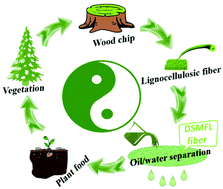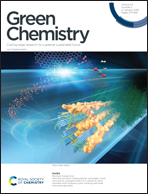Degradable dual superlyophobic lignocellulosic fibers for high-efficiency oil/water separation†
Abstract
Industrial emissions and oil spills as worldwide challenges have induced severe pollution and threatened the ecological environment. Conventionally, superhydrophobic surfaces show underwater lipophilicity, whereas superhydrophilic surfaces exhibit underwater oleophobicity. However, the intrinsic characteristics of these materials limit their practical applications for dealing with industrial oily wastewater. Here, from a chemical point of view, a lignocellulosic fiber surface with superwetting characteristics was successfully fabricated by the strategically adjusted condensation reaction of melamine and formaldehyde, making it underoil superhydrophobic and underwater superoleophobic. The formation of the dual superlyophobic surface in oil/water systems was related to the surface topography and the essential chemistry of the modified lignocellulosic fibers. After being pre-wetted by water, the dual superlyophobic melamine formaldehyde lignocellulosic (DSMFL) fibers were able to separate a light-oil/water mixture by gravity filtration. Simultaneously, the DSMFL fibers were sufficient to separate a heavy-oil/water mixture when they were pre-wetted by a heavy oil under a gravity-driven mechanism. In addition, the DSMFL fibers still showed excellent dual superlyophobicity along with robust chemical stability and had high separation efficiencies for dichloroethane (DCE)/water or kerosene/water mixtures after 50 separation cycles. The effective absorption of the light oil on the upper layer of the aqueous phase exceeded 1000%. Finally, the DSMFL fibers could be degraded into a nitrogen source for plant growth.



 Please wait while we load your content...
Please wait while we load your content...